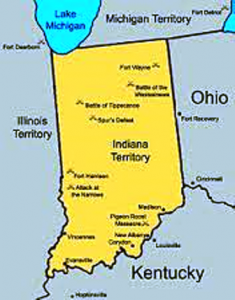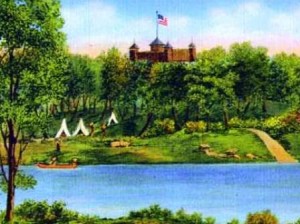Archive for May 1st, 2013
» posted on Wednesday, May 1st, 2013 by Linda Lou Burton
Birth Of A Capital City
 Linda Burton posting from Indianapolis, Indiana –How many capital cities have the name of the state within the name of the city? The answer is at the end of this post, but obviously Indianapolis is one. The name was created by joining “Indiana” with “polis,” which is the Greek word for “city.” Yes, Indianapolis literally means Indiana City (like Oklahoma City, a trivia hint for you). So the next question is “what does Indiana mean?” I won’t go into all of the Indian wars and treaties that occurred as the United States expanded westward; I’ll start with July 4, 1800, when Indiana Territory was pulled out of the larger Northwest Territory. Vincennes, a former French trading post and one of the only white settlements in the vast territory, was named capital. At that time about five thousand white Europeans lived north of the Ohio River; Native Americans
Linda Burton posting from Indianapolis, Indiana –How many capital cities have the name of the state within the name of the city? The answer is at the end of this post, but obviously Indianapolis is one. The name was created by joining “Indiana” with “polis,” which is the Greek word for “city.” Yes, Indianapolis literally means Indiana City (like Oklahoma City, a trivia hint for you). So the next question is “what does Indiana mean?” I won’t go into all of the Indian wars and treaties that occurred as the United States expanded westward; I’ll start with July 4, 1800, when Indiana Territory was pulled out of the larger Northwest Territory. Vincennes, a former French trading post and one of the only white settlements in the vast territory, was named capital. At that time about five thousand white Europeans lived north of the Ohio River; Native Americans  occupied most of the Territory, referred to as “Land of the Indians,” aka Indiana. Fast forward to December 1813: Corydon was named the second capital of Indiana Territory, and the wheels began to turn for statehood. President James Madison approved Indiana’s admission into the Union December 11, 1816 as the 19th state. The capital could not be located in the central part of the state at that time because the land was controlled by Native Americans; however in an 1818 treaty the area was opened for white settlement; an unprecedented migration followed. A central location for a capital city became imperative then; on January 11, 1820 Governor Jennings commissioned 10 men to select a site for the permanent capital. They chose a spot at the junction of Fall Creek and White River; the legislature ratified their selection January 6, 1821, and the building of a capital city began. Enter Alexander Ralston. » read more
occupied most of the Territory, referred to as “Land of the Indians,” aka Indiana. Fast forward to December 1813: Corydon was named the second capital of Indiana Territory, and the wheels began to turn for statehood. President James Madison approved Indiana’s admission into the Union December 11, 1816 as the 19th state. The capital could not be located in the central part of the state at that time because the land was controlled by Native Americans; however in an 1818 treaty the area was opened for white settlement; an unprecedented migration followed. A central location for a capital city became imperative then; on January 11, 1820 Governor Jennings commissioned 10 men to select a site for the permanent capital. They chose a spot at the junction of Fall Creek and White River; the legislature ratified their selection January 6, 1821, and the building of a capital city began. Enter Alexander Ralston. » read more
